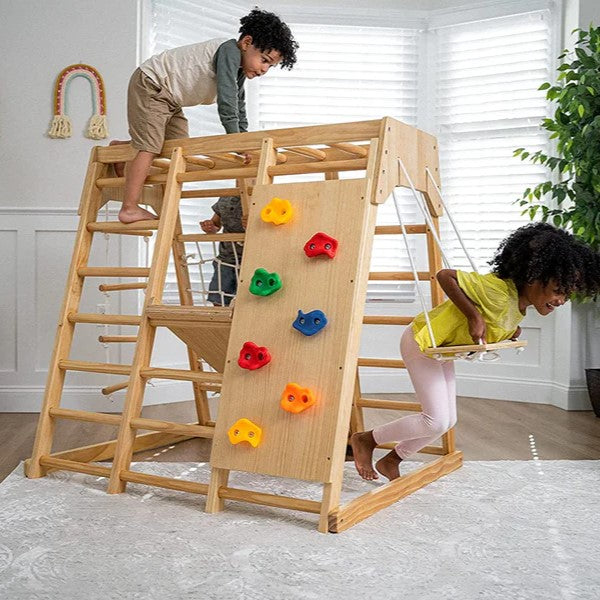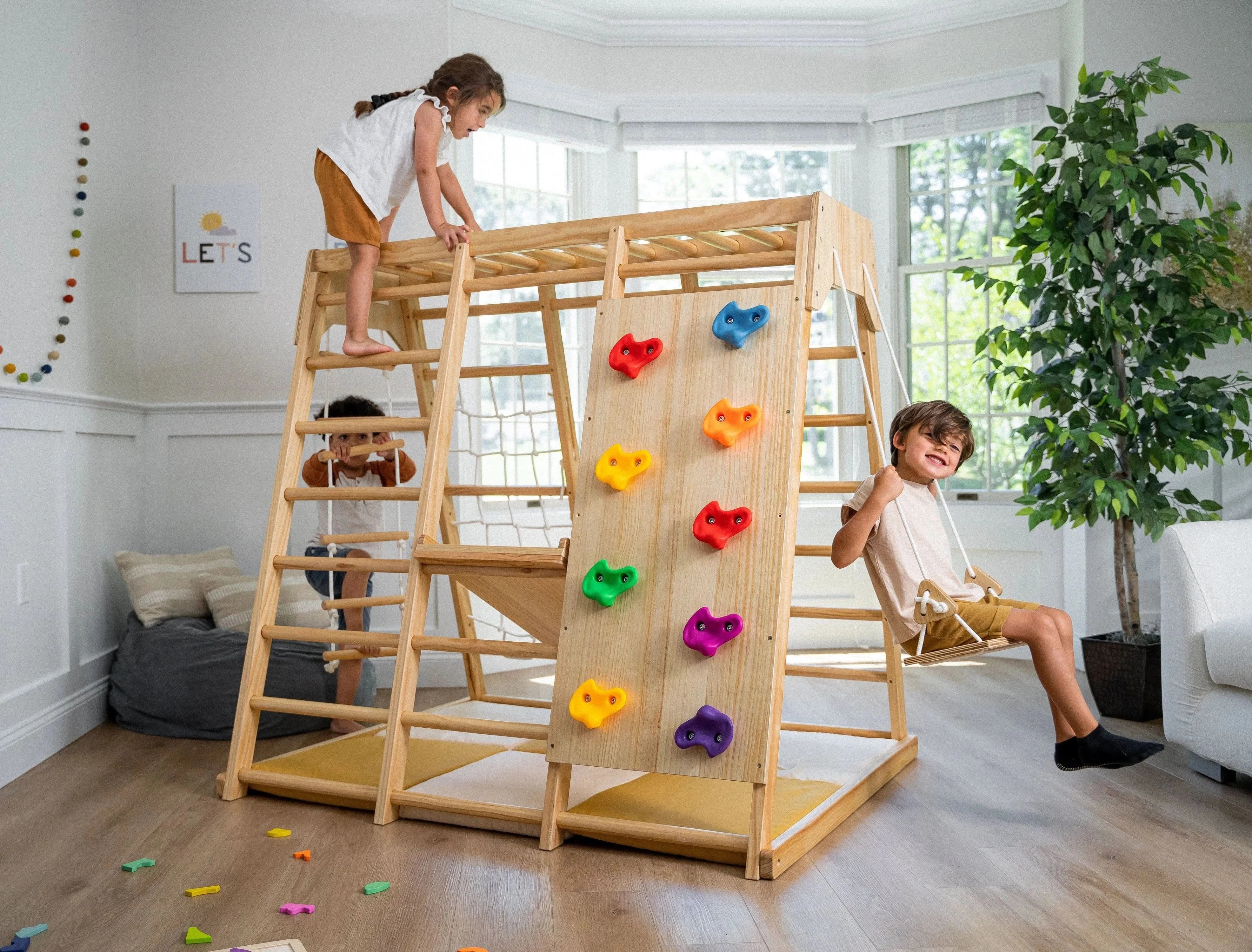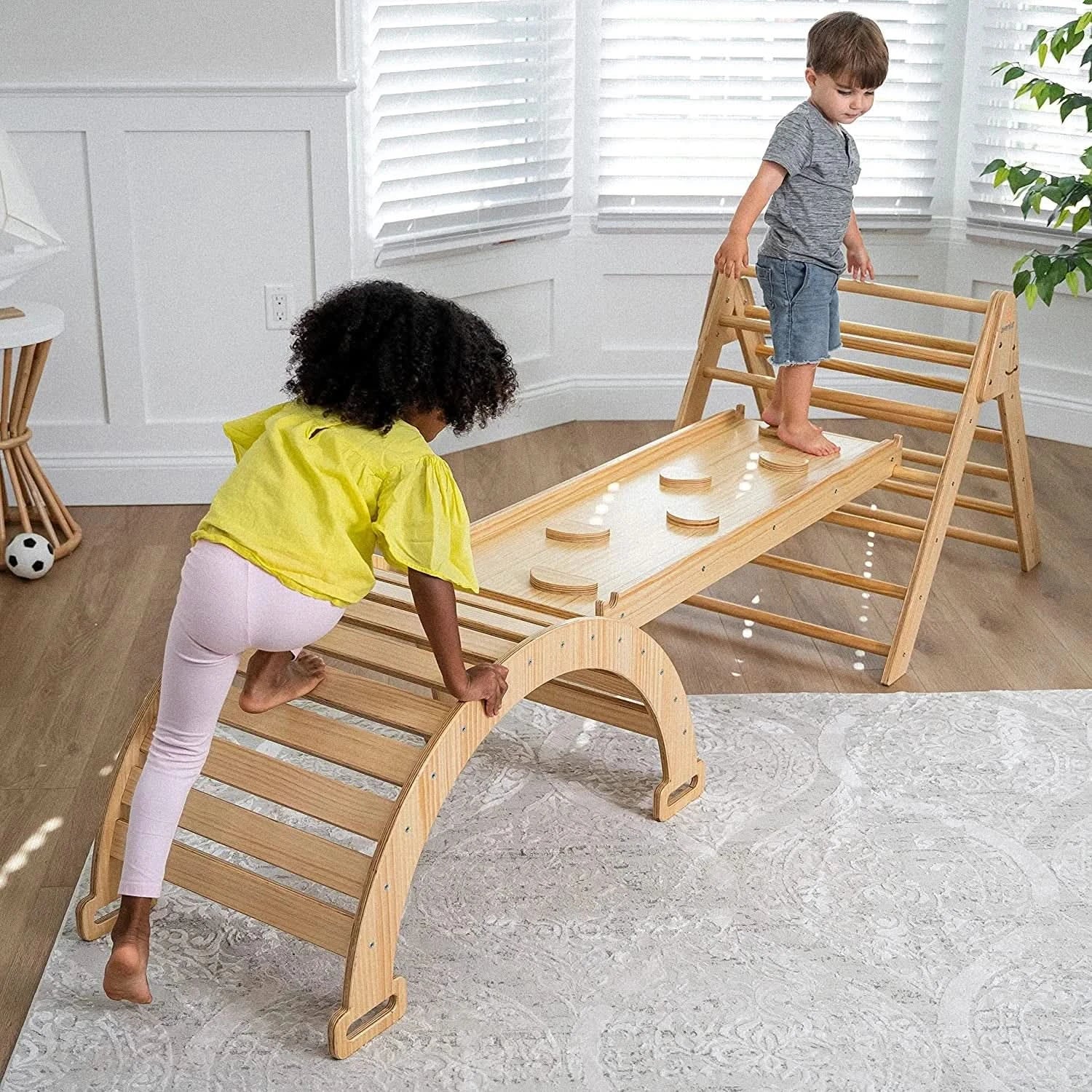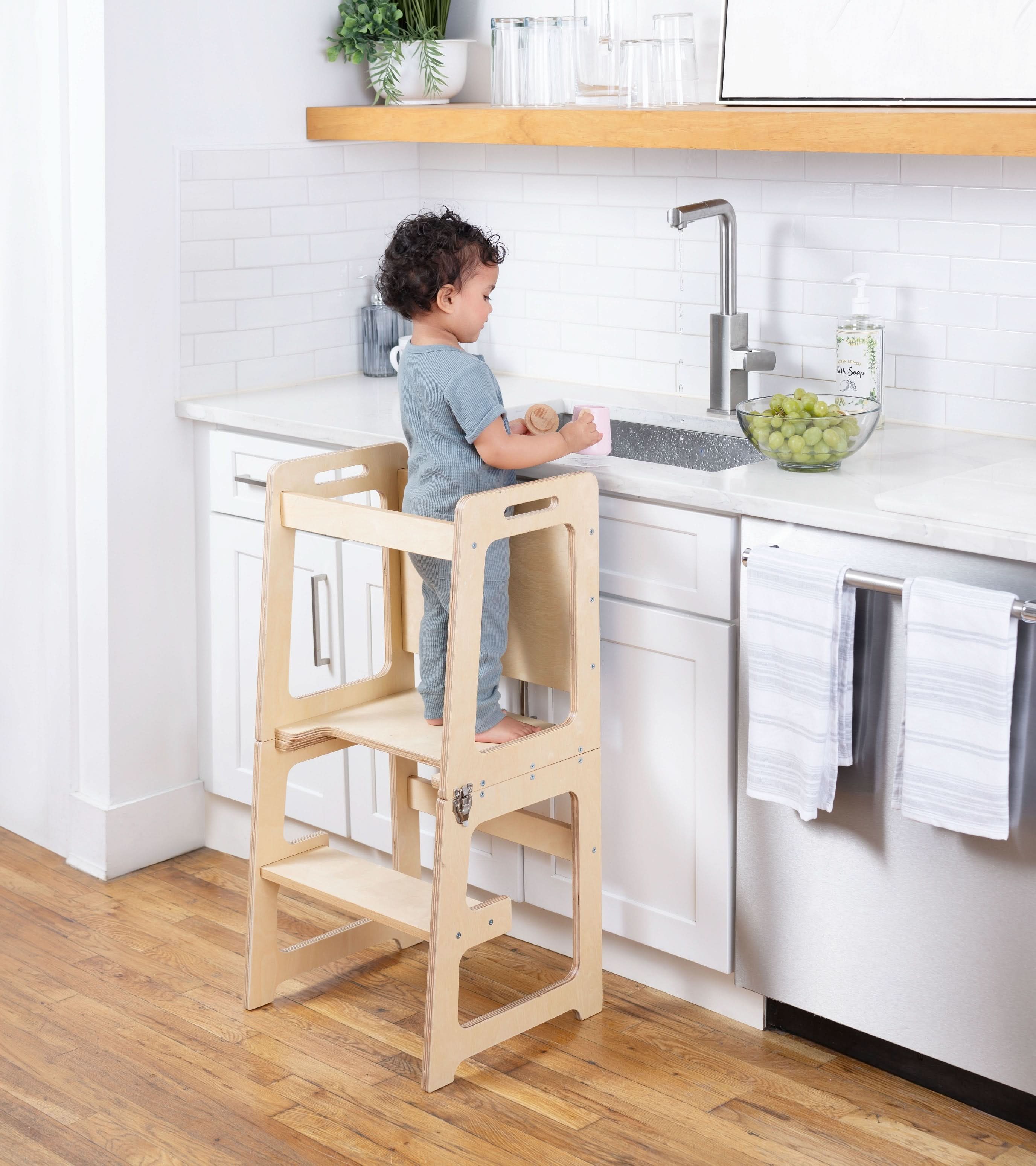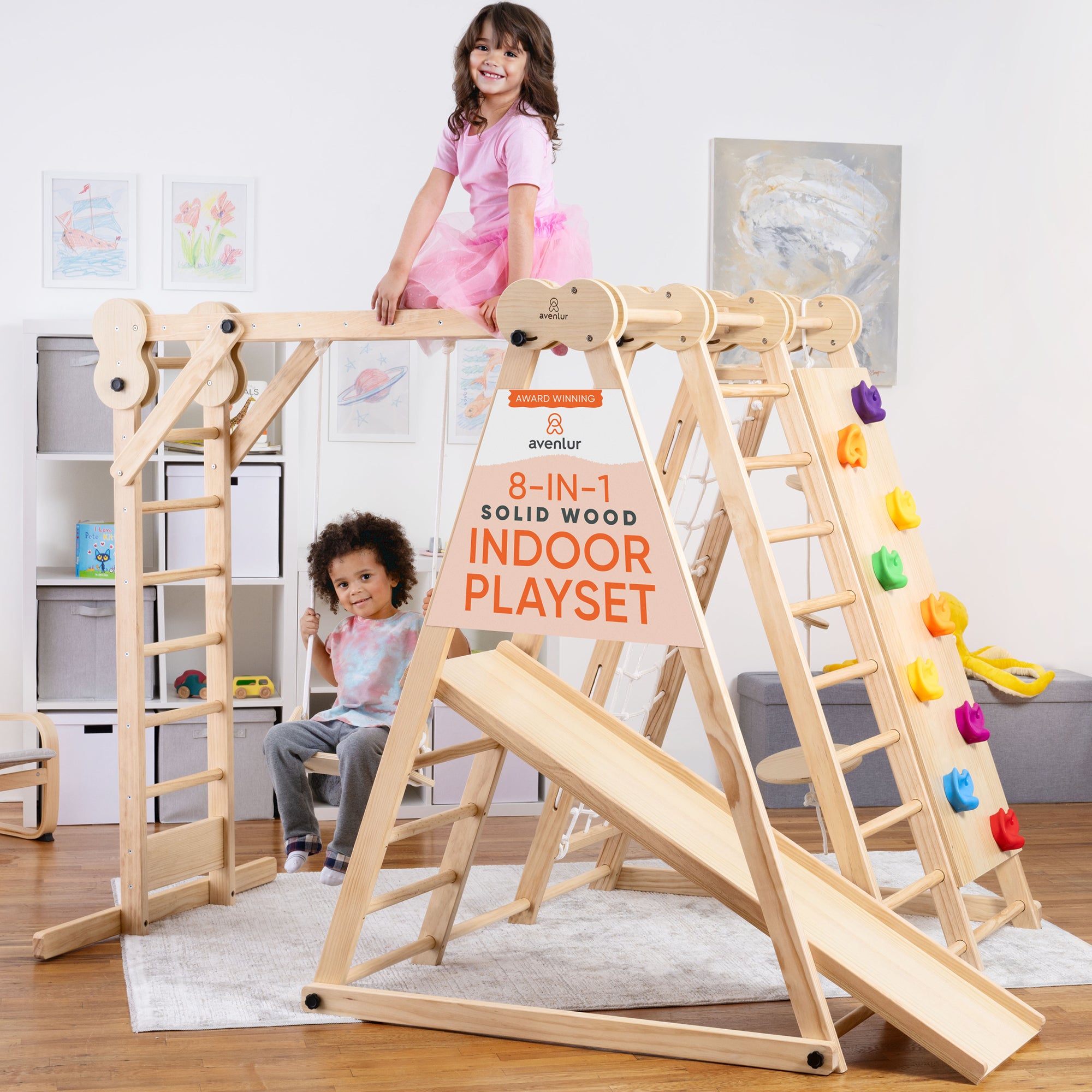The Ultimate Pikler Triangle Buying Guide
Loved for their simple, sturdy wooden structure, the Pikler triangle benefits can be far-reaching, helping young children to develop their motor skills and confidence through independent, open-ended play.
We believe they’re a must-have for any Montessori enthusiasts or first-time parents, as they’re such a simple way to encourage safe developmental play. And hey, they’re a lot of fun too!
This guide to Pikler triangle benefits will help you choose the perfect model from Avenlur, where each piece is sustainably made and thoughtfully designed for indoor adventure.
What is a Pikler Triangle?
A Pikler Triangle is a climbing frame designed for toddlers and young children to build physical strength, balance, and confidence through independent movement. Originally developed by Dr. Emmi Pikler, it encourages safe exploration and creativity through climbing, sliding, and imaginative play.
The idea behind it is that children are given the freedom to move at their own pace. Instead of being taught how to climb, it encourages endless physical experiments and problem-solving.
Pikler Triangle Benefits for Child Development
Pikler triangles can be considered as open-ended toys. They don’t dictate play. Instead, they use a simple design of wooden rungs that requires the child to get imaginative. Toddlers naturally become keen to climb up, crawl under, hang on, or imagine a new world with their Montessori climbing triangle.
This self-directed approach strengthens muscles, balance, and spatial awareness - all key gross motor skills. Toddlers who use the Pikler Triangle also noticeably boost their self-confidence and resilience, as they learn to assess risk and decision-making.
The natural wood in our Montessori climbing triangles also provides tactile stimulation, connecting children with natural materials and creating strong brain connections.
And it doesn’t stop there, as we’ve heard countless stories of kids transforming their triangles into dens, forts, and space rockets while interacting in social play and cooperation.
What Age is Best for a Pikler Triangle?
Pikler Triangles for Babies (Around 6 Months+)
Most people associate climbing with older children, but babies start climbing long before they walk. Our Pikler triangles can be introduced as early as 6 months old. Of course, you won’t see them climbing at that age, but even the pulling and lifting of feet onto the first rung is the first step in developing core strength.
But it's when your child becomes a toddler that the Pikler triangle benefits kick in. As they teach themselves how to climb, descend, and balance, they’ll start to push their abilities and boost their motor skills and confidence.
In preschool ages, advanced play arrives. You can then start to combine your Pikler triangle with other climbing playsets to create obstacle courses and imaginary worlds!
Watch the Pikler in Action
Choosing the Right Pikler Triangle for Your Child
Ok, let’s start helping you decide which Pikler triangle is best suited to your little explorer’s needs and your wonderful parenting vision.
We’ve separated this into five categories:
1️⃣ Practicality
2️⃣ Materials and finish
3️⃣ Accessory compatibility
4️⃣ Size
5️⃣ Safety
Practicality
For any family, space is always a luxury. There’s always another thing in the way.
If that sounds like a problem for you, then go for a foldable Pikler triangle. These are total game-changers, allowing for easy storage. So whether you want to clear it up for bedtime, or until your next baby is born, you can!
Don’t worry, our foldable Pikler Triangles are just as sturdy as any non-foldable ones. We’ve carefully designed locking mechanisms, and our triangles meet ASTM and CPSIA standards.
Materials and Finish
First up, you need to consider what it's made of. There are hundreds of Pikler Triangles on Amazon, but they’re made from cheap woods that aren’t safe. Cheap versions are prone to breaking, splintering, or causing health issues due to their nasty vanish.
We use premium, eco-friendly, FSC-certified New Zealand pine. It’s coated with a non-toxic, BPA-free varnish, so your little ones are safe even if they start licking it!
Quality wood and finishes naturally come at a premium, but you can’t put a price on the safety of your child.
Accessory Compatibility
Add-ons give you the chance to transform the usual use of a Pikler triangle. These can open up new worlds of play, or just make them really practical!
Our Pikler Triangles are designed to work with our accessories, including a tent covering or a desk and chair attachment.
Size
Not everyone has an enormous living room. So, you’ll want to think carefully about the size of your chosen Pikler triangle. They come in various sizes, from 24 inches. Anything around 26 inches is perfect for a mix of age ranges, where you want your kids to be using them as they develop through being a toddler to a young child.
Pikler Triangle Safety
Settle for nothing less than a Montessori climbing triangle that meets ASTM and CPSIA standards. Designs with those certifications are made of non-toxic materials to prevent long-term health issues and are sturdy enough to support your little ones as they grow and push them without care.
Be wary of cheap deals that don’t meet these standards, as they’re likely cutting corners to save cash. It can also be wise to place a foam mat or soft rug under the triangle to protect from tumbles (and floor dents)!
Avenlur’s Top Pikler Triangle Picks
Hazel Foldable Pikler Triangle
Shop the Hazel Foldable Pikler Triangle
Our most versatile recommendation is our best-seller. ‘Hazel’ offers a classic triangle design with a reversible slide that doubles as a rock wall. It folds for easy storage and is perfect for a daily indoor adventure. With a non-toxic BPA-free finish, it’s designed for small bodies and big imagination, with no sharp edges or nasty finger gaps.
Olive Colorful Pikler Triangle
Shop the Olive Colorful Pikler Triangle
The vibrant, colourful version of the Pikler Triangle is available in three sizes and comes with a climber/slide ramp. It easily folds away when not in use and is perfect for bright, active playrooms.
Maple Small Triangle Set
Shop the Maple Small Triangle Set
For new parents welcoming a baby into the world, here’s an adorable, tiny version for your little one!
As a scaled-down triangle for babies and early walkers, it includes a slide, ladder, and rocker to safely introduce movement and motor development.
FAQs on Pikler Triangles:
What age is appropriate for a Pikler triangle?
Our baby version of the Pikler Triangle is suitable as early as 6-11 months! As your baby heads into toddlerhood, they’re free to safely start exploring the regular-sized triangle.
What is the spacing for a Pikler triangle?
Our Pikler triangles are spaced between 3-4 inches apart. This distance is designed to prevent a child’s head from getting stuck, while still allowing free movement of limbs and hands for climbing confidently.
Is the Pikler triangle Montessori?
The Pikler was not strictly a Montessori set, but it aligns closely with Montessori principles such as independent movement, freedom of exploration, and confidence through self-directed play.
Are they worth it?
Pikler triangles are considered a great investment for many parents as they grow with their child. They allow the child to understand their ongoing development and limits, as the triangle remains sturdy and durable.
Start Encouraging Development Today with a Pikler Triangle from Avenlur
A Pikler Triangle is a wonderful way to encourage the simplicity of independent, imaginative play. At Avenlur, we’ve carefully crafted a design that meets the original vision of Dr. Emmi Pikler, without compromising on safety.
Browse our store today to find the dream Pikler triangle for your home.
